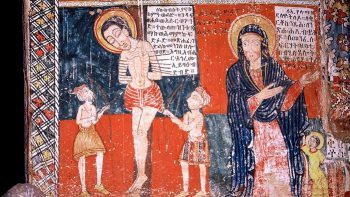Lizzie Wade in Science:
 In the 14th century, the Black Death swept across Europe, Asia, and North Africa, killing up to 50% of the population in some cities. But archaeologists and historians have assumed that the plague bacterium Yersinia pestis, carried by fleas infesting rodents, didn’t make it across the Sahara Desert. Medieval sub-Saharan Africa’s few written records make no mention of plague, and the region lacks mass graves resembling the “plague pits” of Europe. Nor did European explorers of the 15th and 16th centuries record any sign of the disease, even though outbreaks continued to beset Europe. Now, some researchers point to new evidence from archaeology, history, and genetics to argue that the Black Death likely did sow devastation in medieval sub-Saharan Africa. “It’s entirely possible that [plague] would have headed south,” says Anne Stone, an anthropological geneticist who studies ancient pathogens at Arizona State University (ASU) in Tempe. If proved, the presence of plague would put renewed attention on the medieval trade routes that linked sub-Saharan Africa to other continents. But Stone and others caution that the evidence so far is circumstantial; researchers need ancient DNA from Africa to clinch their case. The new finds, to be presented this week at a conference at the University of Paris, may spur more scientists to search for it.
In the 14th century, the Black Death swept across Europe, Asia, and North Africa, killing up to 50% of the population in some cities. But archaeologists and historians have assumed that the plague bacterium Yersinia pestis, carried by fleas infesting rodents, didn’t make it across the Sahara Desert. Medieval sub-Saharan Africa’s few written records make no mention of plague, and the region lacks mass graves resembling the “plague pits” of Europe. Nor did European explorers of the 15th and 16th centuries record any sign of the disease, even though outbreaks continued to beset Europe. Now, some researchers point to new evidence from archaeology, history, and genetics to argue that the Black Death likely did sow devastation in medieval sub-Saharan Africa. “It’s entirely possible that [plague] would have headed south,” says Anne Stone, an anthropological geneticist who studies ancient pathogens at Arizona State University (ASU) in Tempe. If proved, the presence of plague would put renewed attention on the medieval trade routes that linked sub-Saharan Africa to other continents. But Stone and others caution that the evidence so far is circumstantial; researchers need ancient DNA from Africa to clinch their case. The new finds, to be presented this week at a conference at the University of Paris, may spur more scientists to search for it.
Plague is endemic in parts of Africa now; most historians have assumed it arrived in the 19th century from India or China. But Gérard Chouin, an archaeologist and historian at the College of William & Mary in Williamsburg, Virginia, and a team leader in the French National Research Agency’s GLOBAFRICA research program, first started to wonder whether plague had a longer history in sub-Saharan Africa while excavating the site of Akrokrowa in Ghana. Founded around 700 C.E., Akrokrowa was a farming community surrounded by an elliptical ditch and high earthen banks, one of dozens of similar “earthwork” settlements in southern Ghana at the time. But sometime in the late 1300s, Akrokrowa and all the other earthwork settlements were abandoned. “There was a deep, structural change in settlement patterns,” Chouin says, just as the Black Death ravaged Eurasia and North Africa. With GLOBAFRICA funding, he has since documented a similar 14th century abandonment of Ife, Nigeria, the homeland of the Yoruba people, although that site was later reoccupied.
More here.
